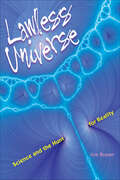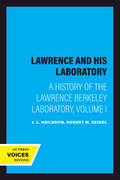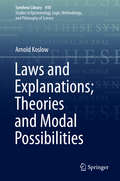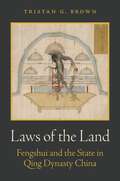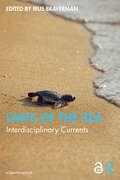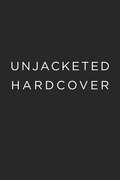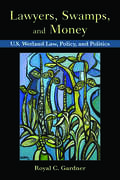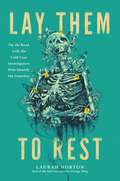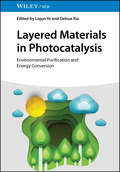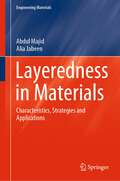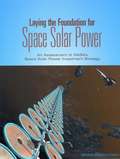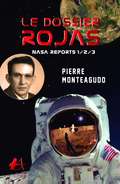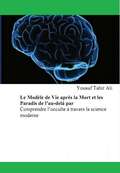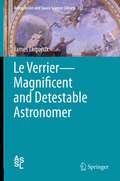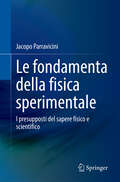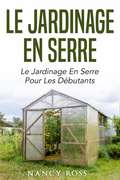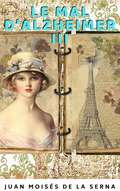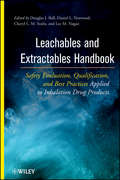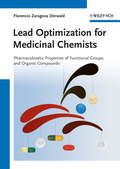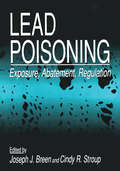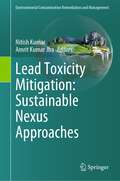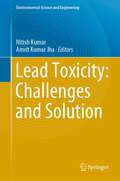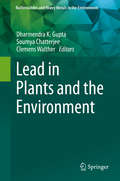- Table View
- List View
Lawless Universe: Science and the Hunt for Reality
by Joe RosenCan science fully comprehend the whole of the material universe? Not according to Joe Rosen.There is no question that advancements in science—especially in physics—have radically changed our concept of nature, revolutionizing our view of the universe, even of reality itself. Rosen argues, though, that the material universe in its entirety lies beyond science. Anyone who claims otherwise, who proposes a scientific Theory of Everything to explain all aspects and phenomena of nature, only misleads and misinforms. Taking science—and the scientific method—down a peg, Rosen asserts that any understanding of the whole universe, if it is to be found at all, can come only from outside science, from nonscientific modes of comprehension and insight. He believes that popularizers of science—think Stephen Hawking and Richard Dawkins—are mistaken when they declare that science is on the verge of unlocking all the secrets of the universe. Perhaps without realizing it, they have crossed into the realm of metaphysics in an attempt to explain the unexplainable. In Lawless Universe Rosen explores just how far science can go in comprehending nature. He considers the separate—but entangled—domains of science and metaphysics and examines the all-too-often ignored boundary between the objective and the subjective. Thought-provoking and controversial, Lawless Universe is a complement to, even an antidote for, books that create the misimpression that science can explain everything.
Lawless Universe: Science and the Hunt for Reality
by Joe RosenIn this provocative reassessment of science, a physicist questions whether it can ever fully comprehend the entire material universe.There is no question that modern science has radically advanced our understanding of nature, the universe, and even reality itself. But in Lawless Universe, theoretical physicist Joe Rosen takes the scientific method down a peg. In his estimation, people like Stephen Hawking and Richard Dawkins are wrong to declare that science is on the verge of unlocking all the secrets of the universe. Perhaps without realizing it, they have crossed into the realm of metaphysics in an attempt to explain the unexplainable. Rosen considers the separate but entangled domains of science and metaphysics and examines the all-too-often ignored boundary between the objective and the subjective. He asserts that any understanding of the whole universe, if it is to be found at all, must come from nonscientific modes of comprehension and insight.
Lawrence and His Laboratory: A History of the Lawrence Berkeley Laboratory, Volume I (California Studies in the History of Science #5)
by J. L. Heilbron Robert W. SeidelThe Radiation Laboratory in Berkeley, California, was the birthplace of particle accelerators, radioisotopes, and modern big science. This first volume of its history is a saga of physics and finance in the Great Depression, when a new kind of science was born.Here we learn how Ernest Lawrence used local and national technological, economic, and manpower resources to build the cyclotron, which enabled scientists to produce high-voltage particles without high voltages. The cyclotron brought Lawrence forcibly and permanently to the attention of leaders of international physics in Brussels at the Solvay Congress of 1933. Ever since, the Rad Lab has played a prominent part on the world stage.The book tells of the birth of nuclear chemistry and nuclear medicine in the Laboratory, the discoveries of new isotopes and the transuranic elements, the construction of the ultimate cyclotron, Lawrence's Nobel Prize, and the energy, enthusiasm, and enterprise of Laboratory staff. Two more volumes are planned to carry the story through the Second World War, the establishment of the system of national laboratories, and the loss of Berkeley's dominance of high-energy physics.
Laws and Explanations; Theories and Modal Possibilities (Synthese Library #410)
by Arnold KoslowThe book has two parts: In the first, after a review of some seminal classical accounts of laws and explanations, a new account is proposed for distinguishing between laws and accidental generalizations (LAG). Among the new consequences of this proposal it is proved that any explanation of a contingent generalization shows that the generalization is not accidental. The second part involves physical theories, their modality, and their explanatory power. In particular, it is shown that (1) Each theory has a theoretical implication structure associated with it, such that there are new physical modal operators on these structures and also special modal entities that are in these structures. A special subset of the physical modals, the nomic modals are associated with the laws of theories. (2) The familiar idea that theories always explain laws by deduction of them has to be seriously modified in light of the fact that there are a host of physical theories (including for example, Newtonian Classical mechanics, Hamiltonian, and Lagrangian theory, and probability theory) that we believe are schematic (they do not have any truth value). Nevertheless, we think that there is a kind of non-deductive explanation and generality that they achieve by subsumtion under a schema.
Laws of the Land: Fengshui and the State in Qing Dynasty China
by Tristan G. BrownA groundbreaking history of fengshui’s roles in public life and law during China’s last imperial dynastyToday the term fengshui, which literally means “wind and water,” is recognized around the world. Yet few know exactly what it means, let alone its fascinating history. In Laws of the Land, Tristan Brown tells the story of the important roles—especially legal ones—played by fengshui in Chinese society during China’s last imperial dynasty, the Manchu Qing (1644–1912).Employing archives from Mainland China and Taiwan that have only recently become available, this is the first book to document fengshui’s invocations in Chinese law during the Qing dynasty. Facing a growing population, dwindling natural resources, and an overburdened rural government, judicial administrators across China grappled with disputes and petitions about fengshui in their efforts to sustain forestry, farming, mining, and city planning. Laws of the Land offers a radically new interpretation of these legal arrangements: they worked. An intelligent, considered, and sustained engagement with fengshui on the ground helped the imperial state keep the peace and maintain its legitimacy, especially during the increasingly turbulent decades of the nineteenth century. As the century came to an end, contentious debates over industrialization swept across the bureaucracy, with fengshui invoked by officials and scholars opposed to the establishment of railways, telegraphs, and foreign-owned mines.Demonstrating that the only way to understand those debates and their profound stakes is to grasp fengshui’s longstanding roles in Chinese public life, Laws of the Land rethinks key issues in the history of Chinese law, politics, science, religion, and economics.
Laws of the Sea: Interdisciplinary Currents
by Irus BravermanLaws of the Sea assembles scholars from law, geography, anthropology, and environmental humanities to consider the possibilities of a critical ocean approach in legal studies. Unlike the United Nations’ monumental Convention on the Law of the Sea, which imagines one comprehensive constitutional framework for governing the ocean, Laws of the Sea approaches oceanic law in plural and dynamic ways. Critically engaging contemporary concerns about the fate of the ocean, the collection’s twelve chapters range from hydrothermal vents through the continental shelf and marine genetic resources to coastal communities in France, Sweden, Florida, and Indonesia. Documenting the longstanding binary of land and sea, the chapters pose a fundamental challenge to European law’s “terracentrism” and its pervasive influence on juridical modes of knowing and making the world. Together, the chapters ask: is contemporary Eurocentric law—and international law in particular—capable of moving away from its capitalist and colonial legacies, established through myriad oceanic abstractions and classifications, toward more amphibious legalities? Laws of the Sea will appeal to legal scholars, geographers, anthropologists, cultural and political theorists, as well as scholars in the environmental humanities, political ecology, ocean studies, and animal studies.
Laws, Theories, and Patterns in Ecology
by Walter K. DoddsIntroductory material describes how the practice of science in general, and ecology specifically, yields theories and laws. Dodds also discusses why such ideas are only useful if they have predictive ability, and delineates the scope of these generalizations and the constraints that limit their application.
Lawyers, Swamps, and Money: U.S. Wetland Law, Policy, and Politics
by Royal C GardnerLawyers, Swamps, and Money is an accessible, engaging guide to the complex set of laws governing America's wetlands. After explaining the importance of these critical natural areas, the book examines the evolution of federal law, principally the Clean Water Act, designed to protect them. Readers will first learn the basics of administrative law: how agencies receive and exercise their authority, how they actually make laws, and how stakeholders can influence their behavior through the Executive Branch, Congress, the courts, and the media. These core concepts provide a base of knowledge for successive discussions of: the geographic scope and activities covered by the Clean Water Act the curious relationship between the U.S. Army Corps of Engineers and the Environmental Protection Agency the goal of no net loss of wetlands the role of entrepreneurial wetland mitigation banking the tension between wetland mitigation bankers and in-lieu fee mitigation programs wetland regulation and private property rights. The book concludes with insightful policy recommendations to make wetlands law less ambiguous and more effective. A prominent legal scholar and wetlands expert, professor Royal C. Gardner has a rare knack for describing landmark cases and key statutes with uncommon clarity and even humor. Students of environmental law and policy and natural resource professionals will gain the thorough understanding of administrative law needed to navigate wetlands policy-and they may even enjoy it.
Lay Them to Rest: On the Road with the Cold Case Investigators Who Identify the Nameless
by Laurah NortonTake a fascinating deep dive into the dark world of forensic science as experts team up to solve the identity of an unknown woman by exploring the rapidly evolving techniques being used to break the most notorious cold cases. Fans of true crime shows like CSI, NCIS, Criminal Minds, and Law and Order know that when it comes to &“getting the bad guy&” behind bars, your best chance of success boils down to the strength of your evidence—and the forensic science used to obtain it. Beyond the silver screen, forensic science has been used for decades to help solve even the most tough-to-crack cases. In 2018, the accused Golden State Killer, Joseph DeAngelo, was finally apprehended after a decades-long investigation thanks to a very recent technique called forensic genealogy, which has since led to the closure of hundreds of cold cases, bringing long-awaited justice to victims and families alike. But when it comes to solving these incredibly difficult cases, forensic genealogy is just the tip of the iceberg—and many readers have no idea just how far down that iceberg goes. For Laurah Norton, forensic science was always more of a passion than anything else. But after learning about a mishandled 1990s cold case involving missing twins, she was spurred to action, eventually creating a massively popular podcast and building a platform that helped bring widespread attention and resources to the case. LAY THEM TO REST builds on Laurah&’s fascination with these investigations, introducing readers to the history and evolution of forensic science, from the death masks used in Ancient Rome to the 3-D facial reconstruction technology used today. Incorporating the stories of real-life John & Jane Does from around the world, Laurah also examines how changing identification methods have helped solve the most iconic cold cases. Along the way readers will also get to see Laurah solve a case in real time with forensic anthropologist Dr. Amy Michael, as they try to determine the identity of &“Ina&” Jane Doe, a woman whose head was found in a brush in an Illinois park in 1993. More than just a chronicle of the history of forensics, LAY THEM TO REST is also a celebration of the growing field of experts, forensic artists, and anthropologists (many of whom Laurah talks to in the book), who work tirelessly to bring closure to these unsolved cases. And of course, this book asks why some cases go unsolved, highlighting the &“missing missing,&” the sex workers, undocumented, the cases that so desperately need our attention, but so rarely get it. Engrossing, informative, heartbreaking, and hopeful, LAY THEM TO REST is a deep dive into the world of forensic science, showing readers how far we&’ve come in cracking cases and catching killers, and illuminating just how far we have yet to go.
Layered Materials in Photocatalysis: Environmental Purification and Energy Conversion
by Liqun Ye Dehua XiaIncrease photocatalytic efficiency with cutting-edge materials Photocatalysis, which modifies the rate of reactions stimulated by light absorption, can be a critical component of many catalytic processes. Layered structures can be used in photocatalysis to broaden surface area and generate more numerous reaction sites, which can in turn increase both photocatalytic activity and quantum efficiency. In recent years these layered materials have generated numerous applications in energy production and environmental chemistry. Layered Materials in Photocatalysis introduces these materials, their historical development, and their key properties. Analyzing all major classifications of layered photocatalysts, it details their key environmental and energy applications and offers predictions for future research and development. The result is a crucial volume summarizing a growing technology. Layered Materials in Photocatalysis readers will also find: Combines both science and skills for professionals in the field Detailed discussion of layered bismuth-based photocatalysts, metal-free layered photocatalysts, and many more Authored by one of the leading experts in structured materials in photocatalysis Layered Materials in Photocatalysis is ideal for catalytic chemists, photochemists, and any other scientists working with catalytic or energy-generating processes.
Layeredness in Materials: Characteristics, Strategies and Applications (Engineering Materials)
by Abdul Majid Alia JabeenThis book provides information on the characteristics, strategies and applications of layered materials. It sheds light on layerdness-dependent properties of Van der Waals solids for potential applications. The properties of various layered materials prepared using different experimental strategies are described. Further, the first-principles calculations are given to devise a strategy to investigate layeredness in materials. The structural, thermal, mechanical, lattice vibronic, electronic, optical and carrier transport characteristics of the layered materials are elaborated in detail. This book provides an updated source of information on layered materials for students, researchers, and professionals.
Laying the Foundation for Space Solar Power: An Assessment of NASA's Space Solar Power Investment Strategy
by Committee for the Assessment of NASA's Space Solar Power Investment StrategyInformation on Laying the Foundation for Space Solar Power
Lazare and Sadi Carnot
by Raffaele Pisano Charles C. GillispieLazare Carnot was the unique example in the history of science of someone who inadvertently owed the scientific recognition he eventually achieved to earlier political prominence. He and his son Sadi produced work that derived from their training as engineering and went largely unnoticed by physicists for a generation or more, even though their respective work introduced concepts that proved fundamental when taken up later by other hands. There was, moreover, a filial as well as substantive relation between the work of father and son. Sadi applied to the functioning of heat engines the analysis that his father had developed in his study of the operation of ordinary machines. Specifically, Sadi's idea of a reversible process originated in the use his father made of geometric motions in the analysis of machines in general. This unique book shows how the two Carnots influenced each other in their work in the fields of mechanics and thermodynamics, and how future generations of scientists have further benefited from their work.
Le Dossier Rojas
by Luc Wyn Pierre MonteagudoDescription du livre: Mystères et secrets sont découverts depuis de 5 décennies dans une histoire passionnante qui révèle le complot pour masquer les inventions et les découvertes du docteur Rojas, un scientifique élémentaire pour le débarquement de l’homme sur la lune. Au milieu de la « Guerre Froide », en travaillant pour le NASA, le docteur Rojas s'est réuni avec un président, voyageait á l’ancienne Union Soviétique, prenait la décision fatidique de se rendre á un entrevue á Washington D.C. y depuis, qu'est-ce qui se passait? Les entités impliquées disent que ne savent rien de lui, mais la vérité est cette histoire basée sur la réalité. Quand se rapproche le 50ième anniversaire du premier débarquement d’une équipe sur la lune, nous nous rencontrons avec ce livre fascinant, qui consiste de deux parties. Dans la première, on présente un hommage à la mémoire posthume de l’astrophysicien Héctor R. Rojas, qui pouvait voyager à la lune dans des vols secrets du NASA. Dans la deuxième partie, l’auteur donne ses pensées de toute une vie concernant le phénomène OVNI. Sans doute, il s'agit d’une histoire passionnante écrite dans une langue simple et directe.
Le Modèle de Vie après la Mort et les Paradis de l’au-delà: Comprendre l'occulte par l'usage de la science moderne
by Yousuf Tahir AliL’auteur mène une discussion sur les écritures religieuses notamment l’islam qui se sont révélées vrais au fil de temps. Dans ce contexte il essai de prouver la véracité de telles écritures á partir de l’usage de la science moderne. Pour en arriver á son but, l’auteur fait recours á la science physique d’Einstein (Théorie de relativité) et de Stephen Hawking pour comprendre la vie après la mort en plus d’autres aspects occultes en particulier l’âme et l’esprit. En bref l’œuvre et un mélange de théologie et science que l’auteur essai á les marier en vue d’avoir une confirmation sur une vie éventuelle de l’au-delà.
Le Verrier—Magnificent and Detestable Astronomer
by James LequeuxTranslated from the original French by Bernard Sheehan; Edited and with an introduction by Dr. William Sheehan, a neuroscientist and amateur astronomer who is also a research fellow of the Lowell Observatory in Flagstaff, Arizona Le Verrier was a superb scientist. His discovery of Neptune in 1846 made him the most famous astronomer of his time. He produced a complete theory of the motions of the planets which served as a basis for planetary ephemeris for a full century. Doing this, he discovered an anomaly in the motion of Mercury which later became the first proof of General Relativity. He also founded European meteorology. However his arrogance and bad temper created many enemies, and he was even fired from his position of Director of the Paris Observatory.
Le fondamenta della fisica sperimentale: I presupposti del sapere fisico e scientifico
by Jacopo ParraviciniQuesto libro ha lo scopo di fornire un’ampia riflessione sui principi generali della fisica e gli elementi fondanti della conoscenza scientifica nella loro unitarietà. Sfruttando largamente il pensiero di molti tra i più grandi scienziati, esso offre una chiara comprensione dei fondamenti della fisica e del suo metodo sperimentale, ponendo in risalto le correlazioni tra i principali eterogenei elementi che vi stanno alla base. Si ricorda come le scienze sperimentali non siano statiche ma, al contrario, soggette a continui studi e ripensamenti. Nell'affrontare la mancanza di lezioni o trattazioni sistematiche sulla natura del metodo scientifico nei tradizionali corsi universitari tecnico-scientifici, l'autore si addentra così nello studio di ciò che sta alla base della scienza in generale, e della fisica in particolare. Sono trattati temi quali la relazione tra fenomeni naturali e il linguaggio matematico, mettendo in risalto i principali snodi dello sviluppo concettuale nella scienza. Inoltre l’autore discute l’importanza della “pratica scientifica” sottolineandone il ruolo nell’avanzamento della conoscenza scientifica, e il modo con cui essa contribuisce alla fisica nel suo complesso. Il libro è suddiviso in tre parti, ciascuna delle quali copre differenti aspetti della fisica e dei suoi fondamenti: la prima parte riguarda le radici fenomenologiche e gli strumenti basilari della disciplina; la seconda si concentra sulla struttura della conoscenza scientifica; la terza tratta i metodi pratici dell’indagine scientifica. Il libro rimane accessibile per qualsiasi studente di discipline tecnico-scientifiche, poiché un non fisico sarà agevolmente in grado di trovare facilmente in libri di testo di natura introduttiva spiegazioni di quei concetti fondamentali dati per assodati.
Le jardinage en serre: Le jardinage en serre pour les débutants
by Nancy Ross Gaulthier MarrelVOULEZ-VOUS DECOUVRIR LES TENANTS ET ABOUTISSANT DU JARDINAGE EN SERRE ? Voici un aperçu de ce que vous apprendrez... Installer un potager dans une serre Cultiver des plantes dans votre serre Manières de contrôler le climat dans la serre Certains des meilleures méthodes de plantation dans la serre Comment se débarrasser des insectes nuisibles Et bien plus encore !
Le mal d'Alzheimer III
by Juan Moisés de la SernaComment traite-t-on la maladie d’Alzheimer ? Quelle est son évolution ? Comment peut-on prévenir son évolution ? Apprenez au sujet des dernières avancées en termes de prévention et de traitement de la maladie d’Alzheimer. Un des aspects les plus importants d’une maladie est de savoir comment la vaincre, si elle dispose d’un remède et quel est le traitement. A ce sujet, de nombreux progrès sont réalisés en permanence dans le domaine de la recherche de traitement et de prévention de la maladie d’Alzheimer, comme nous les présenterons dans cet écrit. Objectif : L’objectif du livre est de servir de première approche à toute personne touchée de près ou de loin par la maladie d’Alzheimer, qu’elle soit elle-même la personne malade ou qu’il s’agisse d’un proche. Ce livre cherche à présenter de façon claire les résultats des dernières recherches sur la maladie d’Alzheimer, dans le but de répondre aux questions les plus pertinentes : comment se traite cette maladie ? quelle est son évolution ? comment se prévient-elle ? Destinataires : Professionnels de santé qui doivent approfondir leurs connaissances en termes de diagnostic et de traitement de la maladie d’Alzheimer. Professeurs qui souhaitent fournir une information actualisée à leurs élèves sur la maladie d’Alzheimer. Tous ceux qui ont été diagnostiqués de la maladie d’Alzheimer et leurs proches afin de savoir que faire face à cette maladie Thématique Ci-dessous, voici le détail de chacune des thématiques principales de cette ouvrage : Traitement de l’Alzheimer : malgré les limites des traitements actuels, de nouvelles découvertes sont réalisées chaque jour afin de faire face à cette maladie Évolution de l’Alzheimer : la maladie d’Alzheimer se définit comme une maladie progressive, c’est-à-dire qu’avec le temps, elle provoque la perte des capacités co
Leachables and Extractables Handbook
by Douglas J. Ball Cheryl L. Stults Daniel L. Norwood Lee M. NagaoA practical and science-based approach for addressing toxicological concerns related to leachables and extractables associated with inhalation drug productsPackaging and device components of Orally Inhaled and Nasal Drug Products (OINDP)-such as metered dose inhalers, dry powder inhalers, and nasal sprays-pose potential safety risks from leachables and extractables, chemicals that can be released or migrate from these components into the drug product. Addressing the concepts, background, historical use, and development of safety thresholds and their utility for qualifying leachables and extractables in OINDP, the Leachables and Extractables Handbook takes a practical approach to familiarize readers with the recent recommendations for safety and risk assessment established through a joint effort of scientists from the FDA, academia, and industry. Coverage includes best practices for the chemical evaluation and management of leachables and extractables throughout the pharmaceutical product life cycle, as well as: Guidance for pharmaceutical professionals to qualify and risk-assess container closure system leachables and extractables in drug products Principles for defining toxicological safety thresholds that are applicable to OINDP and potentially applicable to other drug products Regulatory perspectives, along with an appendix of key terms and definitions, case studies, and sample protocolsAnalytical chemists, packaging and device engineers, formulation development scientists, component suppliers, regulatory affairs specialists, and toxicologists will all benefit from the wealth of information offered in this important text.
Lead Optimization for Medicinal Chemists
by Florencio Zaragoza DörwaldSmall structural modifications can significantly affect the pharmacokinetic properties of drug candidates. This book, written by a medicinal chemist for medicinal chemists, is a comprehensive guide to the pharmacokinetic impact of functional groups, the pharmacokinetic optimization of drug leads, and an exhaustive collection of pharmacokinetic data, arranged according to the structure of the drug, not its target or indication. The historical origins of most drug classes and general aspects of modern drug discovery and development are also discussed. The index contains all the drug names and synonyms to facilitate the location of any drug or functional group in the book.This compact working guide provides a wealth of information on the ways small structural modifications affect the pharmacokinetic properties of organic compounds, and offers plentiful, fact-based inspiration for the development of new drugs. This book is mainly aimed at medicinal chemists, but may also be of interest to graduate students in chemical or pharmaceutical sciences, preparing themselves for a job in the pharmaceutical industry, and to healthcare professionals in need of pharmacokinetic data.
Lead Poisoning: Exposure, Abatement, Regulation
by Joseph J. Breen Cindy R. StroupLead Poisoning discusses one of the most critical and preventable environmentally induced illnesses. The actual toll lead poisoning takes on society cannot be measured fully due to the "silent" nature of health effects, such as subtle intellectual deficits and neurological damage, caused by chronic low-level exposures. This book covers every major topic on the subject, including lead poisoning in children, sources of contamination, state-of-the-art sampling and analytical measurement methods, the newest studies on low-cost abatement methods, and much more. This reference is the most comprehensive presentation of issues currently available under one cover.The text is divided into three major parts. Part I provides insights from studies assessing lead exposures from paint, dust, soil, and lead battery recycling operations. The second part is a unique collection of strategic federal policy statements from the U.S. EPA, HUD, and HEW-CDC. It details the National Implementation Plan as well as a local government's efforts to provide low-cost effective risk communication and public outreach to the community. The next part offers seven chapters on analytical issues in the measurement of lead in blood, paint, dust, and soils. Part IV, Sampling Methods and Statistical Issues, rounds out the technical portion of the volume. The relationships among lead levels in biological and environmental media are investigated and the interpretive problems discussed. The use of multi-element analysis of environmental samples as an approach to investigate sources is described.The book finishes with its most unique feature-OPPT's Check Our Kids for Lead Program, one organization's effort to empower its employees to make a personal difference in confronting the problem of lead poisoning in children. The Program serves as a model for other government organizations (federal, state, and local), university and community organizations, and corporations to educate them and take personal and corporate responsibility for addressing this important and environmental health problem.
Lead Toxicity Mitigation: Sustainable Nexus Approaches (Environmental Contamination Remediation and Management)
by Nitish Kumar Amrit Kumar JhaThis edited book brings together a diverse group of researchers to address the challenges posed by global mass poisoning caused by lead contamination of soil and plants. Lead is among the elements that have been most extensively used by man over time. This has led to extensive pollution of surface soils on the local scale, mainly associated with mining and smelting of the metal and addition of organic lead compounds to petrol. Release of lead to the atmosphere from various high-temperature processes has led to surface contamination on the regional and even global scale. Lead is particularly strongly bound to humic matter in organic-rich soil and to iron oxides in mineral soil and is rather immobile in the soil unless present at very high concentrations. In addition, plants grown on lead-rich soils incorporate lead and thus the concentration of lead in crop plants may be increased. Lead enters in the food chain through consumption of plant material. A high concentration of lead has been found to be harmful to vegetation. As the lead concentration increases, it adversely affects several biological parameters and eventually renders the soil barren. The book sheds light on this global environmental issue and proposes solutions to contamination through multi-disciplinary approaches. This book contains three sections. First section describes the different sources and distribution of lead in soil and plant ecosystems. Second section explains the health risks linked to lead toxicity. Third section addresses sustainable lead toxicity mitigation strategies using the potential applications of recent biological technology. This book is a valuable resource to students, academics, researchers, and environmental professionals doing field work on contamination throughout the world.
Lead Toxicity: Challenges and Solution (Environmental Science and Engineering)
by Nitish Kumar Amrit Kumar JhaThis book delivers an outline to graduate, undergraduate students, and researchers, as well as academicians who are working on lead toxicity with respect to remediation. It covers sources of lead contamination and its impact on human health and on prospective remediation through multi-disciplinary approaches with application of recent advanced biological technology. Lead is among the elements that have been most extensively used by man over time. This has led to extensive pollution of surface soils on the local scale, mainly associated with mining and smelting of the metal and addition of organic lead compounds to petrol. Release of lead to the atmosphere from various high-temperature processes has led to surface contamination on the regional and even global scale. In addition, plants grown on lead-rich soils incorporate lead, and thus, the concentration of lead in crop plants may be increased. Lead enters in the food chain through consumption of plant material. A high concentration of lead has been found to be harmful to vegetation. As the lead concentration increases, it adversely affects several biological parameters and eventually renders the soil barren. This edited book brings together a diverse group of researchers to address the challenges posed by global mass poisoning caused by lead contamination of soil and plants. The book sheds light on this global environmental issue and proposes solutions to contamination through multi-disciplinary approaches. This book contains three sections. The first section describes the different sources and distribution of lead in soil and plant ecosystems. The second section explains the health risks linked to lead toxicity. The third section addresses sustainable lead toxicity mitigation strategies and the potential applications of recent biological technology in providing solutions. This book is a valuable resource to students, academics, researchers, and environmental professionals doing fieldwork on lead contamination throughout the world.
Lead in Plants and the Environment (Radionuclides and Heavy Metals in the Environment)
by Dharmendra K. Gupta Clemens Walther Soumya ChatterjeeThis book examines the way that lead enters the biosphere and the subsequent environmental impact. The contributing authors include international experts who provide methods for assessing and characterizing the ecological risk of lead contamination of soil and plants. Information is provided on the consequences for human health as a result of lead pollution. This book reveals that approximately 98% of stable lead in the atmosphere originates from human activities.Lead in Plants and the Environment reports on methods for detecting, measuring, and assessing the concentration of lead in plants. The authors provide a method for the measurement of 210Pb isotopes in plants. This method can be applied extensively in different environmental settings, not only as a way of revealing sources of lead, but also as a way to monitor lead transport in plants and animals that ingest them.The chapters include coverage on the following topics:· Lead bioavailability in the environment and its exposure and effects· Radioanalytical methods for detecting and identifying trace concentrations of lead in the environment· Lead contamination and its dynamics in soil plant systems· Lead pollution monitoring and remediation through terrestrial plants in mesocosm constructed wetlands· A review of phytoremediation of leadThis book is a valuable resource to students, academics, researchers, and environmental professionals doing field work on lead contamination throughout the world.
